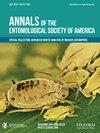橡树瘿蜂的异交性生命周期需要关闭——从两种树蜂的经验(膜翅目:蜂科:蜂蜂)
IF 3
3区 农林科学
Q1 ENTOMOLOGY
引用次数: 2
摘要
在异源瘿蜂中,即使在同一物种内,无性代和有性代的瘿结构、物候和成虫形态也存在差异。早在1904年就发现了日本鳞蟾(Dryophanta japonica Ashmead)和三kurii鳞蟾(Dryophanta mitsukurii Ashmead),但它们的异交生活期并不确定。为了匹配它们的无性代和有性代,我们将这两种物种的模式标本与饲养的瘿蜂标本进行了比较,以证明异源性的生命周期。这表明这两个物种分别是一个异交种的无性代和有性代。根据形态特征,我们将日本金丝雀转移到Melika和Pujade-Villar作为日本金丝雀(Ashmead, 1904)的梳子。此外,我们还研究了先前被认为与木栗木同义的其他物种的模式标本。结果表明,vonkuenburgi Dettmer, 1934 syn11 .(和vonkuenburgi wakayamensis Monzen, 1954 syn11 .)是日本血吸虫的无性代,bonihenrici Dettmer, 1934 syn11 .)是有性代。从原始描述来看,浅川新创,1943年11月,神奈川新创,1943年11月,浅川新创,1944年11月,神奈川新创,1944年11月,柏山新鹭,1954年11月也被认为是日本蠓的性代。最后,我们讨论了杂种瘿蜂无性代与有性代的匹配不仅避免了分类上的混淆,而且有助于瘿蜂生物学的进展。本文章由计算机程序翻译,如有差异,请以英文原文为准。
The Heterogonic Life Cycles of Oak Gall Wasps Need to Be Closed: A Lesson From Two Species of Dryophanta (Hymenoptera: Cynipidae: Cynipini)
Abstract In heterogonic gall wasps, the gall structure, phenology, and adult morphology differ between the asexual and sexual generations, even within the same species. Dryophanta japonica Ashmead and Dryophanta mitsukurii Ashmead were described in 1904, but their heterogonic life cycles were uncertain. To match their asexual and sexual generations, we compared the type specimens of both species with specimens of gall wasps reared to demonstrate heterogonic life cycles. This revealed that these two species are the respective asexual and sexual generations of a single heterogonic species. Based on the morphological characteristics, we transferred D. japonica to Cerroneuroterus Melika and Pujade-Villar as Cerroneuroterus japonicus (Ashmead, 1904) comb. nov. and treated the sexual generation as a junior synonym: Dryophanta mitsukurii Ashmead, 1904 syn. nov. Moreover, we examined the type specimens of other species previously suggested to be synonymous with D. mitsukurii. This showed that Neuroterus vonkuenburgi Dettmer, 1934 syn. nov. (and N. vonkuenburgi wakayamensis Monzen, 1954 syn. nov.) is the asexual generation of C. japonicus and that Neuroterus bonihenrici Dettmer, 1934 syn. nov. is the sexual generation. Judging from the original descriptions, Andricus asakawae Shinji, 1943 syn. nov., Andricus kanagawae Shinji, 1943 syn. nov., Andricus asakawae Shinji, 1944 syn. nov., Andricus kanagawae Shinji, 1944 syn. nov., and Neoneuroterus kashiyamai Monzen, 1954 syn. nov. were also regarded as the sexual generation of C. japonicus. Finally, we discussed how matching asexual and sexual generations in heterogonic gall wasps not only avoids taxonomic confusion but also contributes to progress in gall wasp biology.
求助全文
通过发布文献求助,成功后即可免费获取论文全文。
去求助
来源期刊
CiteScore
4.90
自引率
0.00%
发文量
25
审稿时长
6-12 weeks
期刊介绍:
The Annals of the Entomological Society of America exists to stimulate interdisciplinary dialogue across the entomological disciplines and to advance cooperative interaction among diverse groups of entomologists. It seeks to attract and publish cutting-edge research, reviews, collections of articles on a common topic of broad interest, and discussion of topics with national or international importance. We especially welcome articles covering developing areas of research, controversial issues or debate, and topics of importance to society. Manuscripts that are primarily reports of new species, methodology, pest management, or the biology of single species generally will be referred to other journals of the ESA. The most important criteria for acceptance are quality of work and breadth of interest to the readership.

 求助内容:
求助内容: 应助结果提醒方式:
应助结果提醒方式:


